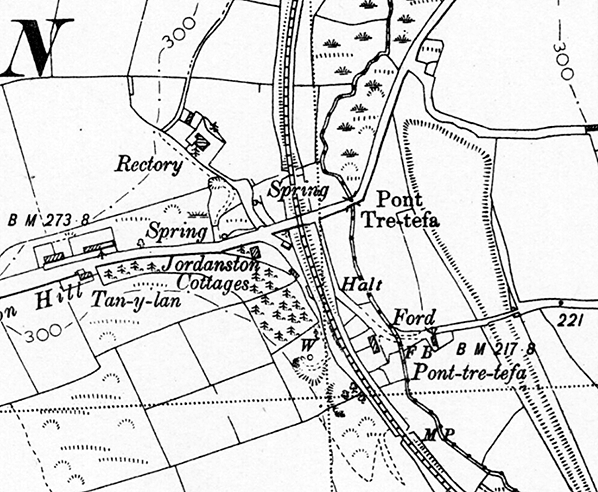
Station Name: JORDANSTON HALT[Source: Nick Catford]
halt_old2.jpg) Class 5700 0-6-0PT No.9602 pauses at Jordanston Halt (looking north). One imagines a passenger has left the train to take the photograph before boarding again; railway staff in rural areas could be quite obliging in this way. Jordanston Halt had two platforms but in 1958 the double track north of Letterston Junction was singled. The sleeper edging of the up platform can be made out on the left. This appears to be the same train as photographed at Fishguard & Goodwick on a dismal day in September 1963; the telltale sign is that No.9602's smokebox door handles are in exactly the same position. Jordanston Halt was an example of the low-platform halts at which the retractable steps of the auto-coaches would be used. The track appears to be well maintained and the water lying on the sleepers suggests that the creosote is doing what was intended.
Photo from John Mann collection  
1953 1:10560 OS map, the halt is 50yd south of the road crossing. The embankment to the east of the halt is part of the unfinished works for the New Line, authorized in 1903 to avoid the severe gradients on the existing line to Fishguard, with construction beginning sometime around 1906. The New Line would then have joined the existing one between Letterston Junction and Jordanston Halt.
halt_old1.jpg)
Jordanston Halt looking south-east c1964. The halt only ever had very basic facilities and no lighting. The low, almost ground level, platform was typical of halts built with railmotor or autotrain services in mind. Such trains were often fitted with retractable steps for boarding and alighting but when they were not, portable wooden steps were kept at the halts concerned. GWR autotrains serving Jordanston had retractable steps but the line also saw GWR diesel railcars but the arrangements for these, if indeed they called at Jordanston, are unclear.
Photo from John Mann collection halt1.jpg) In September 1967 the sleeper edging of the down platform could still be seen. This platform had been out of use since 1958 when the line was singled.
Photo by Nick Catford halt2.jpg) The site of Jordanston Halt looking south-east in April 1974. The lifted down line is on the right.
Photo by John Mann halt2.jpg)
Looking north-west towards the site of Jordanston Halt in December 2016. The up platform, which remained open until 1964, was on this side of the track.
Photo by Ted Burgess halt3.jpg)
The inclined path up the side of the embankment to the up platform in December 2016. The gate is unlikely to be original. Access to the track is maintained for use by track-maintenance personnel.
Photo by Ted Burgess halt4.jpg)
The west side of Jordanston Hill bridge looking north-east in December 2016. When the line was singled the original double-track deck was replaced with one accommodating a single track.
Photo by Ted Burgess halt5.jpg) Jordanston Hill bridge looking south-west. The path to the halt is to the right of the bridleway sign.
Photo by Ted Burgess
|
 Notes: As road transport became more popular throughout West Wales a number of halts were opened in an effort to boost passenger traffic. The first of these,
Notes: As road transport became more popular throughout West Wales a number of halts were opened in an effort to boost passenger traffic. The first of these,

 Home Page
Home Page